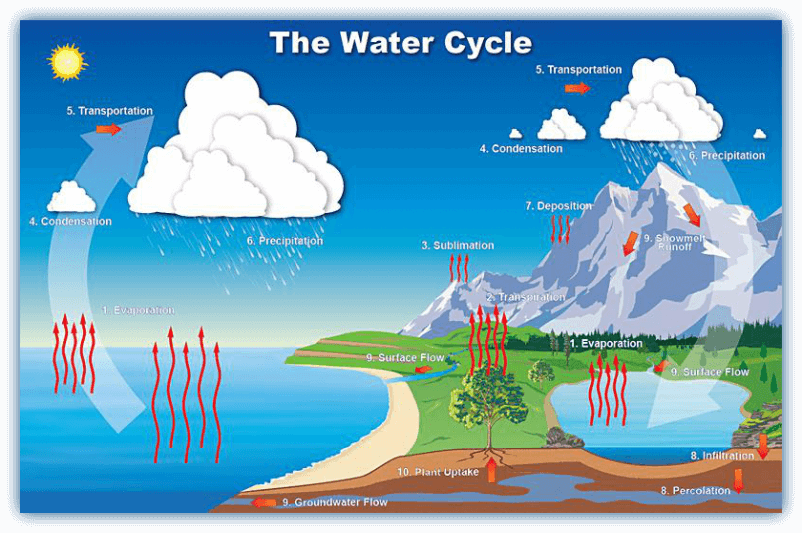A follower asked, “if the water cycle is real, how can there be water shortages?” In light of the recent drought in Texas, which ultimately ended with the historic rainfall during the month of May 2015, and the ongoing devastating drought in California, I thought I would make this brief post.
What is the Water Cycle?
The complete water cycle involves many, many things; however, the two most important components are evaporation and condensation. To get precipitation, you have to have condensation (water vapor in the atmosphere condenses into clouds and the water droplets continue to grow until they are large enough to fall as rain drops). In order to get water vapor into the atmosphere, there has to be evaporation (from wet soil, lakes, rivers, oceans, and even transpiration from vegetation) and sublimation from ice/snow.
Forcing Mechanisms and Blocked Patterns: Impact on the Water Cycle
Moisture that evaporates into the atmosphere is transported by the wind to other places (moisture can travel hundreds/thousands of miles from its source region before it arrives at a location with conditions favorable for condensation). In the last sentence, I said “conditions favorable for condensation”… by that, I mean sufficient vertical forcing to cause the air to rise (rising air condenses). Moisture can travel very long distances before encountering such a forcing mechanism. In the case of a drought (water shortage), the large-scale atmospheric flow pattern is “locked” in place such that storm systems and their forcing mechanisms are absent over the drought region. Upper-level disturbances that cause the air to rise (and cause water vapor to condense) will travel AROUND the area instead of into and over the area; also, frontal boundaries (that cause low-level forcing/lift) can’t make it into the area because of the blocking pattern.
Local Forcing & Periodic Convection
So, in the absence of forcing/vertical motion, there is no way to get the moisture in the atmosphere to condense into water droplets and fall as rain. Even in a blocked pattern, some rain can still occur on *very* small scales (temporally and spatially) from processes like air forced up mountainous terrain or convection (rising air from afternoon heating) which can cause thunderstorms. This latter condition is not sufficient to break a drought because it doesn’t happen over a large enough area and it doesn’t happen on a regular basis. In the Southeast U.S., for example, “airmass” thunderstorms are common in the summertime, because the atmosphere is extremely moist and often unstable (a necessary for thunderstorms); but even in a drought, those afternoon thunderstorms do very little to help drought conditions. In this part of Texas, we rarely get airmass thunderstorms (for reasons that would take too long to explain here).
With all of that said, droughts and water shortages boil down to a blocked pattern and the resultant lack of large-scale forcing for *widespread* precipitation. I’ll also add that there is a feedback loop that kicks in: as a drought progresses, area lakes, rivers, and ground moisture dry out resulting in less and less evaporation. Also, vegetation dies, there is less and less transpiration. Eventually, even the regions that often see afternoon “airmass” thunderstorms will begin to see fewer and fewer. Finally, drought conditions cause the atmosphere to heat up and the hotter atmosphere can reinforce the blocking pattern (a process that would take too long to explain here). Thus, the drought gets worse and worse, and the entire process continues in a feedback loop. Ultimately, it will take a large-scale pattern change (like we saw in North Texas in May of 2015) to bring multiple disturbances/forcing mechanisms into the region and generate persistent heavy-rain events.
In Closing…
So, indeed there is a water cycle; it’s not a theory — it’s actually a thing. If there is a drought/water shortage, it usually boils down to an unfavorable atmospheric pattern that blocks the necessary forcing mechanisms required for precipitation formation. I’ll include an image… notice the component on this graphic that says “transportation”. That includes both moisture transportation (from significant moisture sources, like the Gulf of Mexico) and also the large-scale forcing mechanisms (upper-level disturbances) that can force the air to rise and condense into rain. I hope this answers your question.

